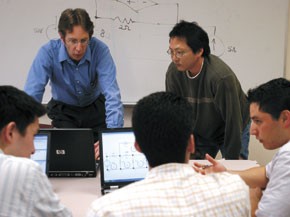Teaching Practices When Laptops are Required
It's common in the U.S. for business schools and even entire universities to have a ubiquitous computing initiative in place. Some schools are changing their initiative to require Tablet PCs. Whatever the case, what are students and faculty to do with the machine once it's use is universal?
The paper brings up the significance of communities of practice:
Palincsar et al (1998: 17) suggest that learning is social in nature, reminding us that “sharing our (teaching) experiences in terms of (the) principles and practices” is important if we are to broadly understand the best use of laptops in teaching activities. Palincsar et al take “sharing further,” by creating an academic community of practitioners, in order to see how community based learning supports development amongst academics.
The paper continues:
The following summary points were abstracted from a series of exploratory interviews and focus groups with staff members from 4 courses over the academic year 2003/2004. Results from research presented key themes (obtained from data analysis and transcripts) in which is was identified that:
1. of the four courses studied, one course implemented a customised and content related “laptop policy” which was used to mediate interaction and use of laptops in class between lecturers and students engaged in learning.
2. all four courses had different implementation plans for the use of, and inclusion of, laptops in class and for assignments. In conversation all staff members mentioned the use of office tools extensively in assignments.
3. the use of small group teaching classrooms were conducive to a more intimate and “interactive learning environment.” Teaching staff also supported this trend and felt there was more interaction and communication in small group settings.
4. lecturers learned “through experience” when to use and when not to use laptops in class for teaching activities, reflecting instruction to use laptops at “appropriate” points in the curricula and learning process.
More research is needed on how teaching practices change once a ubiquitous computing initiative is implemented. For now, until we can prove it, we can only hope that learning is enhanced by these initiatives, which are costly for students.






